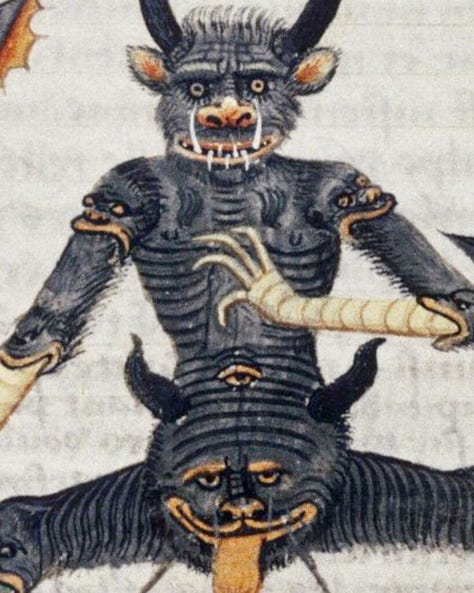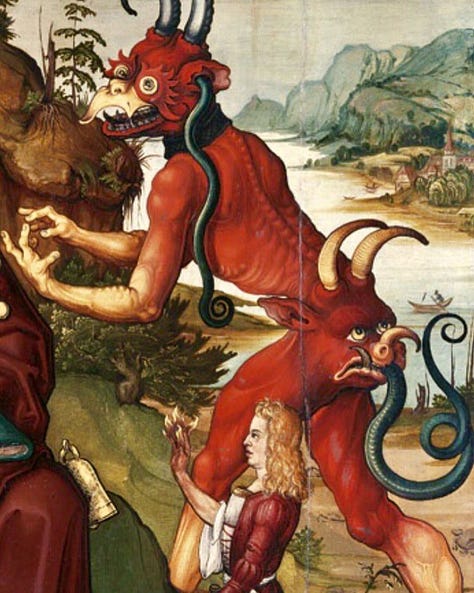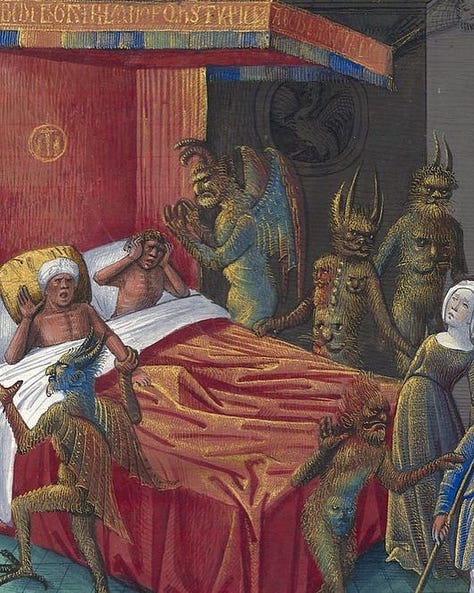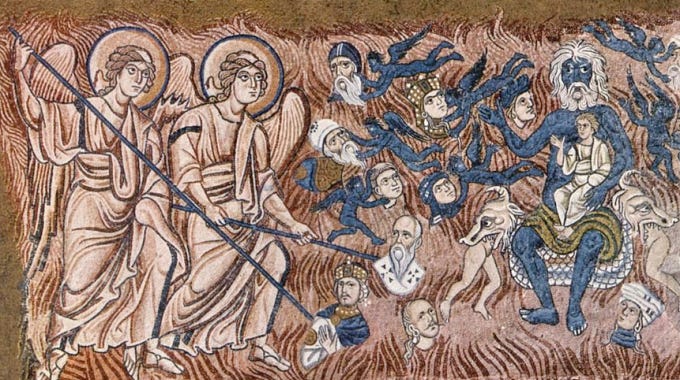Why Demons are Real, and Necessary
An introduction to Byzantine Demonology
Please note that as a long read, not all of this post will show up in your inbox. Just click on the “read more” link at the bottom to see the full post, or click here to view the full post in your browser.
News in brief
Lovers of French Symbolism, the Belle Epoque, and the French Occult Revival: do check out my other Substack dedicated to my research on French visionary Author Joséphin Péladan. There is much crossover with the themes explored here, from a different angle.
My Birth of the Greek Gods course on Hesiod’s Theogony is running here on Thyrathen for all paid subscribers. There are many free samples available, take a look right here. New videos posted weekly.
I’ve mixed up the order of posts just a little in response to reader feedback. I will alternate between various topics and will return to those already announced in due course.
Thank you all so much for your support of Thyrathen! Your support is allowing me to continue this research while also sharing and building community. Thank you for your appreciation of the work that goes into every post. Please know that every contribution, however small, is gratefully received.
Summary: Today’s offering introduces Byzantine demonology, how it is conceptualised, how it differs from Western demonology, and what it meant to Greek-speaking Orthodox populations. It includes the names and attributes of demons, their origins, and their nature. The title is significant: we also discover precisely how real, and surprisingly close to home some of them are, even for non-believers. Read on to find out why!
As always, the introduction is open to all readers, with in-depth exploration reserved for paid subscribers. Weeks of research is represented in each piece; please consider a paid subscription to help support this publication and to join the conversation!
I understand that may not be possible, so I invite you to take advantage of the free trial option, and maybe you can buy me a coffee if you enjoy reading it!



To Western readers, the term demonology often conjures images familiar from medieval manuscripts, Gothic novels, and Hollywood thrillers. Hellfire, brimstone, and perhaps Faustian pacts are among the standard props. From the 19th century on we also encounter a more noble form of the rebel angel, courtesy of the French Revolution.
Its uses, religious and discursive functions are manifold, from imposition of Church authority to the need for a narrative to explain the world’s horrors, and a convenient repository for unthinkable Others.1 Whether from movies or occult handbooks, their names are many, their forms manifold.
In the Greek mind, and certainly in the Byzantine tradition, things are a little different.
Demonological material forms perhaps one of the greatest paper, material, and ethnographic trails of evidence for clear continuities of tradition between late antiquity and “Christian” Byzantium through to this day, well accepted by several generations of European scholars.2
This is also one of my most reliable sources for many of the claims I make here on Thyrathen regarding continuity: the evidence has already been produced,3 even if it remains frustratingly siloed by disciplinary boundaries and what I can only call scholarly prejudice.
Subscribe or upgrade for full access to all posts and course! Can’t currently subscribe? Take advantage of the free trial option and buy me a coffee to help support this research!
Byzantine material on demonology is especially… Byzantine, in that vernacular and elite multicultural sources feed into and impact each other to such a degree that they can barely be separated. The best known example of this is in Psellos’ (11th century) On the Demons, in which he incorporates folk traditions alongside his own form of Platonic dialogue discussing the demonology of his day in elaborately formal Greek.
Within this feedback loop, we find some of the most compelling antique survivals that cannot be subjected to clear - artificial - categories (elite vs. rural; canonical vs. unorthodox). When this has been attempted it has resulted in distortion of the material.

The journey of Byzantine demonology can be summarised thus:
An approach that regards the Byzantine evil spirit solely as a historical, or cultural, or mythological, or theological phenomenon oversimplifies the problem, leading to misleading interpretations…. Byzantine demonology emerges from the multifarious and syncretic cultural environment of the late Roman Empire. Though covered with a thin veil of Christian dogma, Byzantine demonology of the tenth century still echoes the roar of late antique cities and the sober conversations of the academicians in the schools of philosophy and rhetoric in Athens, Alexandria, and Antioch… trac[ing] the philosophical and mythological origin of the demon back to the so-called “Homeric” and “Hesiodic” traditions… In the sixth century BC [sic], the Pythagoreans transformed this concept, enriching it with elements of South Italian folklore and traditions… These threads can be traced in the literature and philosophy of the following epochs: in the poetry of Pindar, the mythological approach of Plato, the philosophical speculations of the Neoplatonists, and the viewpoints and reflections of early Christian authors…. Ultimately, Byzantine hagiography develops a non-systematic demonology that borrows elements from the standard concept of demons as fallen angels, Mediterranean mythologies, and contemporary folklore. This eclectic mental structure influenced the Medieval Orthodox world and still significantly impacts modern concepts of the supernatural.4
As this makes clear, Byzantine demonology is a vast topic that cannot be covered in a single post. Today’s -lengthy - offering only just scratches the surface, and I shall return to highlight various aspects from time to time.
Below, following the introduction, sources, names, and core attributes of Byzantine demons, I focus on a key aspect that I have been circling for some time: that of the actual nature of mythical entities in the Greek mindset, whether god or demon, pagan or Christian.
The nature of evil
Early Orthodox dogma is strongly concerned with theodicy - the theology of evil.
This is a tricky concept, for if God is omnipotent, omniscient, and omnibenevolent, evil should not be possible.
The very existence of evil in a monotheistic, monarchic (a single divine power) cosmos contravenes this: if Satan is acting on his own power, then God is not omnipotent.
If he acts without God’s knowledge, able to trick God, then God is not omniscient.
If Satan acts in the full knowledge of God, who is able to stop him, but chooses not to, then God is not omnibenevolent, thus the Christian edifice crumbles.
The theological resolution for this is threefold and rests firmly on two immutable elements of Orthodox doctrine: the impossibility of dualism, and the Orthodox conception of free will - not shared by other Christian denominations.
Firstly, any hint of dualism is immediately associated with Gnosticism, and this is unacceptable because it suggests that God is not omnipotent. This is non-negotiable within Orthodox doctrine and extends through the notion of the sacrality of matter along with the possibility for its restitution.
Therefore, Satan must be acting with the tolerance of God, but can be quashed. The rationale for God permitting Satan to act, is angelic and human free will, an unbreakable covenant. The roots of this seem to derive from Jewish thought; while there have been contradictory perspectives, it is through the Hellenistic Jewish syncretism of Philo of Alexandria that the concept of free will as an intrinsic part of the soul was absorbed into early Orthodox doctrine.5 Scriptural evidence was sought to support this, and the emphasis on free choice - made possible by Christ’s willing incarnation, sacrifice, and resurrection - remains one of the most immutable aspects of Orthodox faith.
At the heart of Orthodox demonology is a unique redeeming factor: demons are not considered naturally evil; a kernel of goodness remains. If they were entirely evil then:
…they would neither be from the good nor have any place among existent things, nor have fallen from the good things, being by their nature always evil. [Thus], they are called evil not in so far as they exist, (for they are from good and had a good existence given them), but in so far as they do not exist, having been unable to keep their original state as the Scriptures say (Jude 6). For in what, tell me, do we say that the demons have done evil, except in ceasing from the permanent state and activity of the divine virtues? They are not completely devoid of good, since they exist and live and think and have in themselves some movement of desire; but they are called evil because they fail in their natural activity… The demonic class is not evil in what it is by nature, but in what it is not.6
In short, given the a priori goodness of manifest creation and sacrality of even subtle matter, demons cannot be wholly and essentially evil, for if they were, they would self-immolate.
I have discussed this in more detail elsewhere and will revisit it anon, but the crux of the argument is that in the Orthodox faith, matter and all of creation are considered inherently good. Evil and sin are an ‘absence’ from goodness, but not irredeemable.
Orthodox opinions vary on the precise nature of demons and whether they have forever forsaken a chance at redemption; nevertheless, in contrast to other denominations, they affirm that humans can overcome their tricks and temptations, with varying degrees and forms of prescribed activities, from prayer to full-scale exorcisms.
The Orthodox baptism ritual is an exorcism along with a physical and spiritual “sealing” of the infant against entry-points for evil; each element highly significant. Far more than a merely symbolic act, it is during baptism that “divine symbols” are “inscribed in our souls,”7 reflecting the significance of this notion of inscribed symbols I have discussed elsewhere.
I may deal with the further theological aspects and the baptism ritual as time - and reader interest - allows (do tell me if you’d like more on this!). For now we turn to look more closely first at the contrast between demons, devils, and their nature, then at the named demons known in Byzantine tradition - both canonical and folk.


